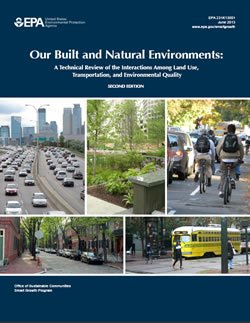Our Built and Natural Environments

Decisions about how and where we built our communities have significant impacts on the natural environment and human health. The U.S. population is projected to substantially in the coming decades, and this has major implications for built and natural environments. While the population roughly doubled between 1950 and 2011 (U.S. Census Bureau), vehicle travel during this same period increased nearly sixfold (Federal Highway Administration 2010 and 2012). Virtually every metropolitan region expanded substantially in land area since 1950 - including regions that lost population during that time (U.S. Census Bureau).*
Cities, regions, states an the private sector need information about the environmental effects of their land use and transportation decisions to mitigate growth-related environmental impacts and to improve community quality of life and human health.
This report builds on the first edition (2001) and incorporates new key findings from hundreds of studies to clarify and illustrate the connections between development patterns, the environment and human health.
Our Built and Natural Environment articulates the relationship between the built environment and the quality of air, water, land resources, habitat, and human health. It also provides evidence that certain kinds of land use and transportation strategies can reduce the environmental and human health impacts of development.
Our Built and Natural Environments: A Technical Review of the Interactions Between Land Use, Transportation, and Environmental Quality (2nd Edition) (pdf) (2013) discusses the environmental effects of land use and transportation decisions to mitigate growth-related environmental impacts and to improve community quality of life and human health.
For example:
- Development in and adjacent to already-developed areas can help protect natural resources like wetlands, streams, coastlines, and critical habitat.
- Residents of transit-oriented developments are two to five times more likely to use transit for commuting and non-work trips than others living in the same region (Arrington and Cervero 2008).
- In general, the greater the population density of an area, the less the area's residents tend to drive (Transportation Research Board of the National Academies 2003). Doubling residential density across a metropolitan region could reduce household vehicle travel by between 5 and 12 percent (National Research Council of the National Academies, Driving and the Built Environment 2009).
- Communities with streets designed for the safety of all users can encourage walking and biking and help people lead healthier lifestyles (Giles et al. 2011).
- A review of green building retrofits of commercial buildings around the world found energy savings of 50 to 70 percent (Harvey 2009).
- Water-efficient household appliances and fixtures can yield significant water savings, and careful selection of construction materials can conserve natural resources and improve indoor air quality. Site-scale green infrastructure can also reduce development's impacts on water quality.
*Full citations for all of the findings are in Our Built and Natural Environments.
